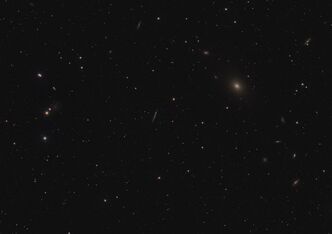Supernovae
Begging of 2021 we put together a Supernova Search Programe taking advantage of the Meade Series 6000 APO 115mm wide field FOV.
A searching algorithm was developed in Mathematica in order to optimize and minimize the mount movements. +300 galaxies were imaged and analysed every clear night during 4 months.
No supernova was discovered (missed 2021hiz for 1 day due to clouds) but the experience worth the effort and time invested. Maybe we'll run another search campaign in the near future.
A searching algorithm was developed in Mathematica in order to optimize and minimize the mount movements. +300 galaxies were imaged and analysed every clear night during 4 months.
No supernova was discovered (missed 2021hiz for 1 day due to clouds) but the experience worth the effort and time invested. Maybe we'll run another search campaign in the near future.
SN 2021hiz in UGC 7513 galaxy
The light curve was acquired with the following equipment:
- Meade APO 115 with focal reducer
- ASI1600 mm cool
- ZWO new R, G, B filter set
Each point consisted in 4 x 5mn exposures thru each filter.
The color calibration of the filters was performed in PI using APASS catalog with stars in the field of view. In particular, the B filter was calibrated using the APASS Blue channel and the APASS B-V index.
According to our data, the B mag maximum occurred on 2021 April the 15th @ 16h GMT+2 at B mag = 13.27. At T max + 15 days, the B mag was recorded at 14.41
The SN absolute magnitude of the maximum was estimated using the Phillips relationship (Wikipedia)
Mmax(B) = -21.726 + 2.698dm15(B)
Mmax(B) = -18.64
The total reddening (due to both interstellar dust and UGC7513 dust), was estimated using the differences between B and V channels at:
- tmax : where a pristine SN shows a B-V of 0.0
- tmax + 15 : where a pristine SN shows a B-V of 1.1
In our case these two values are consistent with a B-V excess: E[B-V] = 0.03
The B extinction is computed as 2 x E[B-V] = 0.06
The corrected Bmag @ max is therefore = 13.21, which set the galaxy distance at 75.7 M light-years or 23.2 M parsecs.
The light curve was acquired with the following equipment:
- Meade APO 115 with focal reducer
- ASI1600 mm cool
- ZWO new R, G, B filter set
Each point consisted in 4 x 5mn exposures thru each filter.
The color calibration of the filters was performed in PI using APASS catalog with stars in the field of view. In particular, the B filter was calibrated using the APASS Blue channel and the APASS B-V index.
According to our data, the B mag maximum occurred on 2021 April the 15th @ 16h GMT+2 at B mag = 13.27. At T max + 15 days, the B mag was recorded at 14.41
The SN absolute magnitude of the maximum was estimated using the Phillips relationship (Wikipedia)
Mmax(B) = -21.726 + 2.698dm15(B)
Mmax(B) = -18.64
The total reddening (due to both interstellar dust and UGC7513 dust), was estimated using the differences between B and V channels at:
- tmax : where a pristine SN shows a B-V of 0.0
- tmax + 15 : where a pristine SN shows a B-V of 1.1
In our case these two values are consistent with a B-V excess: E[B-V] = 0.03
The B extinction is computed as 2 x E[B-V] = 0.06
The corrected Bmag @ max is therefore = 13.21, which set the galaxy distance at 75.7 M light-years or 23.2 M parsecs.
Using the R filter, we can approximately identify the probable location of the NIR second maximum about 28 days after the primary maximum.
Some information on the photometry analysis.
The analysis was performed with PixInsight Aperture Photometry Script.
The RA and DEC of the SN were input as custom object.
Similarly, 2 points adjacent to the SN photometry aperture AND located on each of the SN over the background galaxy (UGC7513) were entered as additional photometric custom objects.
The background level of UGC7513 was estimated as the average between these two reference points, and used for correcting the flux from the SN itself.
The color calibration of the ZWO new RGB filter set was performed for each point (for each day). The Median Absolute Deviation of the reference stars was 0.02 mag on average.
Some information on the photometry analysis.
The analysis was performed with PixInsight Aperture Photometry Script.
The RA and DEC of the SN were input as custom object.
Similarly, 2 points adjacent to the SN photometry aperture AND located on each of the SN over the background galaxy (UGC7513) were entered as additional photometric custom objects.
The background level of UGC7513 was estimated as the average between these two reference points, and used for correcting the flux from the SN itself.
The color calibration of the ZWO new RGB filter set was performed for each point (for each day). The Median Absolute Deviation of the reference stars was 0.02 mag on average.
|
UGC 7513 - SN 2021hiz
Early March 2021 we had put together a Supernova hunting program. The imaging script runs for ~5 hours every 2 to 3 nights, targeting +150 galaxies. On 6th April we captured our first supernova in the faint galaxy UGC 7513 or IC3322a in the constellation Virgo. The explosion was recorded on 30th March as a Ia type, so we were 6 days short... Now we are monitoring its light curve in order to determine the distance to the galaxy. Site: Entre Encinas y Estrellas, Spain Telescope: Meade Series 6000 APO 115 f/5.6 Camera: ZWO ASI1600 Filters: ZWO Lum Date: Reference data March 10th 2021 Exposure: 1x120" |






